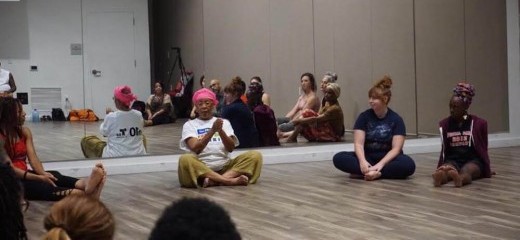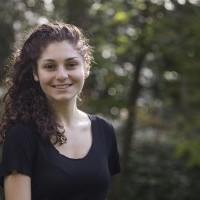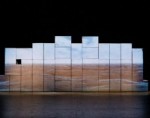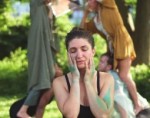
A Way of Being: Awilda Sterling Duprey
by Amelia Estrada
Awilda Sterling Duprey is a multidisciplinary Puerto Rican artist who was recently awarded the seventh Reflection: Response Choreographic Commission by Temple University’s Department of Dance. Her commission, “Lacks Criticality,” to be performed on September 21st and 22nd at Conwell Dance Theater, reflects on Hurricane Maria’s destructive impact on the body, mind, emotions, and physical environment. She was a founding member of the experimental dance collective Pisotón and is a renowned solo artist in Puerto Rico. I spoke with Awilda after attending her workshop at Taller Puertorriqueño where she was introduced by Merián Soto, Professor of Dance at Temple University and one of Awilda’s first improvisation teachers. Awilda shared Orisha dancing and Afro-Cuban movement with those who attended. The workshop was held by Intercultural Journeys as a part of Modupúe | Ibaye: The Philadelphia Yoruba Performance Project.
Amelia Estrada: As a participant in your workshop I noticed your unique use of both folkloric dance and improvisation. Can you tell me about how you developed your teaching style?
Awilda Sterling Duprey: It comes with time and age, but I also had very good teachers. I learned the structure from them and then added my own experience. I think [my teaching style] also has to do with turning to improvisation because my workshops are more open for each person to explore and not to follow a specific way of doing. My folkloric training started with Conjunto Folklórico Nacional de Cuba and continued in NYC with Xiomara Rodríguez, a Cuban Master teacher of the Yoruba religious practice. I learned these dances very strictly, in terms of what comes after what, so [when I teach] I first show how the steps should be and then I incentivize people to feel free to understand their bodies and their own rhythm. The more I understand my own experience the more I am able to share with the community.
AE: Could you talk about your journey into studying African diasporic dances?
ASD: I was introduced to West African dance technique in the early 60's by Sylvia del Villard Gilbert while an undergraduate at the University of Puerto Rico, Rio Piedras campus.
Back then, in Puerto Rico, it was very difficult to acknowledge being of African descent. There is a fallacy that we came from three cultural components: Spanish, always first, Taíno (indigenous Caribbean people), second, and African, always the third and the last. Gilbert pioneered the first interdisciplinary African based dance theater in Puerto Rico, connecting the island within a larger Afro-Caribbean context. Her presence is a constant essence in my life.
AE: What drew you to study folkloric dance in Cuba?
ASD: That was part of looking for my Caribbean-ness in my personality. Cuban music and social dances like guaracha, mambo and cha-cha-cha were staples in my childhood. In 1985, I was doing experimental dance with Pisotón (the first experimental collective in Puerto Rico) and somebody recommended me for an independent artist fellowship. I had started to reflect on the different characteristics of movement of Caribbean people. I started visiting different islands and I saw the movement all around: the waves of the sea and the palm trees. I decided to go to Cuba and study at Conjunto Folklórico Nacional de Cuba to learn about the Orisha dances.
When I moved to New York in 1998 I met Xiomara Rodrigues. We became sisters immediately and I trained with her for four or five years before returning to Puerto Rico. From there I always tried to bring some quality of this to my pieces, even when I was working in a more contemporary or experimental fashion.
AE: Can you tell me about your project at Temple, Lacks Criticality? And about how you typically choreograph a new work?
ASD: I have to understand first how I react to the concept and the context. I am always aware of my surroundings. The composition is the last element that I add. That is why improvisation is the way, the performance, the form, and more than a means for exploring or finding. “Lacks criticality” is a quite common verbal expression used by audience members to cope with their own misunderstanding, confusion, or rejection when experiencing events that shake them in their comfort zone, especially towards contemporary art practices.
If I had been commissioned outside of the university setting, I would not ever think of working with other people. Since Temple is a university that has a dance department, I decided to try working with students. It opens the opportunity for me to work in different styles. I can work more directly from their experiences.
AE: Can you tell me about your choice to primarily be a solo artist?
ASD: One of the reasons I resisted creating a company is because I don’t understand my ideas in other bodies, because they come from my body. Some people resent it or don’t feel comfortable because it is not a technique, it is a way of being. That is why I made the decision to be a solo artist. How I created this body of work has to do with keeping my attention in what is central to me: where I come from, and how I can share that in my performance.
Lacks Criticality, Awilda Sterling Duprey, Conwell Dance Theater, Sept. 21-22
http://www.temple.edu/boyer/about/ReflectionResponsefall2018.asp
By Amelia Rose Estrada
September 4, 2018







